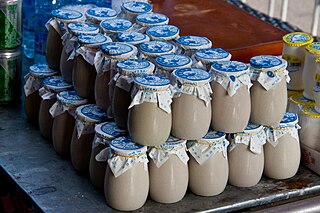Related Research Articles

Tzatziki, also known as cacık or tarator, is a class of dip, soup, or sauce found in the cuisines of Southern Europe and the Middle East. It is made of salted strained yogurt or diluted yogurt mixed with cucumbers, garlic, salt, olive oil, sometimes with vinegar or lemon juice, and herbs such as dill, mint, parsley and thyme. It is served as a cold appetizer (mezze), a side dish, and as a sauce for souvlaki and gyros sandwiches and other foods.

Meze is a selection of small dishes served as appetizers in Albanian, Armenian, Levantine, Turkish, Greek, Iraqi, Egyptian, Balkan, Caucasian and Persian cuisine, to name a few. It is similar to Spanish tapas and Italian antipasti. A mezze may be served as a part of a multi-course meal or form a meal in itself. In non-Islamic countries, or in areas without alcohol restrictions, mezze are often served with spirits such as arak or grappa.

Raita is a side dish in Indian cuisine made of dahi together with raw or cooked vegetables, more seldom fruit, or in the case of boondi raita, with fried droplets of batter made from besan.

Iqt اقط baql بقل mrees مريس mtheer مضير kithy كثي Jameed is a Beduin food consisting of hard dry laban made from ewe or goat's milk. Milk is kept in a fine woven cheesecloth to make a thick yogurt. Salt is added daily to thicken the yogurt even more and the outside of the yogurt-filled cheesecloth is rinsed with water to allow any remaining whey to seep through. After a few days of salting the yogurt, it becomes very dense and can be removed from the cheesecloth and shaped into round balls. It is then set to dry for a few days. If it is dried in the sun it becomes yellow; if it is dried in the shade it remains white. It is important that the jameed is dry to the core because any dampness can spoil the preservation process. Jameed is the primary ingredient used to make mansaf, the national dish of Jordan.

Thukpa is a Tibetan noodle soup, which originated in the eastern part of Tibet. Amdo thukpa is a famous variant among the Indians ,Nepalese and Tibetans. Thukpa can be prepared in both vegetarian and non-vegetarian variations; the most popular non-vegetarian variation includes chicken. There are numerous varieties of thukpa which includes:

Tibetan cuisine includes the culinary traditions and practices of the Tibetan people in the Tibet region. The cuisine reflects the Tibetan landscape of mountains and plateaus and includes influences from neighbors. It is known for its use of noodles, goat, yak, mutton, dumplings, cheese, butter, yogurt, and soups. Vegetarianism has been debated by religious practitioners since the 11th century but is not prevalent due to the difficulty of growing vegetables, and cultural traditions promoting consumption of meat.

A smoothie is a beverage made by puréeing ingredients in a blender. A smoothie commonly has a liquid base, such as fruit juice or milk, yogurt or ice cream. Other ingredients may be added, including fruits, vegetables, non-dairy milk, crushed ice, whey powder or nutritional supplements.

The Sho Dun Festival, commonly known as the Shoton or Yogurt Festival or Banquet since "Sho" means Yogurt and "Dun" means Banquet, is an annual festival held at Norbulingka or "Jewel Park" palace in Lhasa, Tibet Autonomous Region.

Nailao, also known as Beijing yogurt , is a traditional fermented milk drink that is popularly consumed throughout China. The word suannai means "sour milk".
Churri is an Indian spicy side dish, made from yogurt, buttermilk and chiles. It is traditionally preferred as a side dish with Biryani and roasted meats, it is a refreshing supplement to a variety of spicy dishes.

Dahi chutney is strained dahi that is mixed into a chutney of mint and onions, originating from the Indian subcontinent. It is popular in South India and is a side dish along with mirchi ka salan for the popular Hyderabadi biryani.

Tibetan cheese is a food staple in Tibetan cuisine. Tibetan cheeses include soft cheese curds resembling cottage cheese made from buttermilk called chura loenpa. Hard cheese is called chura kampo. Extra hard cheese, made from solidified yogurt, is called chhurpi, and is also found in Sikkim and Nepal. Another type of cheese called shosha or churul, with a flavor said to resemble Limburger, is made from cream and the skin of milk.

Wazwan is a multi-course meal in Kashmiri cuisine, originating from Kashmir.

Yak butter is butter made from the milk of the domestic yak. Many herder communities in China, India, Mongolia, Nepal, Gilgit-Baltistan Pakistan and Tibet produce and consume dairy products made from yak's milk, including butter. Whole yak's milk has about twice the fat content of whole cow's milk, producing a butter with a texture closer to cheese. It is a staple food product and trade item for herder communities in south Central Asia and the Tibetan Plateau.

Toyga is a national meal of Turkish cuisine. It is a yogurt soup cooked with a variety of herbs, wheat and (sometimes) chickpeas.

Yayla çorbası, also known as yoğurtlu çorba, is a Turkish yogurt soup cooked with a variety of herbs, rice, and (sometimes) chickpeas. Variations of it occur throughout the Middle East.

Ash-e doogh is a yogurt soup found in various parts of Iran, such as Azerbaijan and Shiraz, with differing but similar ingredients. Similar dishes are found all over West Asia.
References
- ↑ Li, Tao; Jiang, Hongying (2003). Tibetan customs. 五洲传播出版社. p. 35. ISBN 978-7-5085-0254-0 . Retrieved 5 August 2011.
